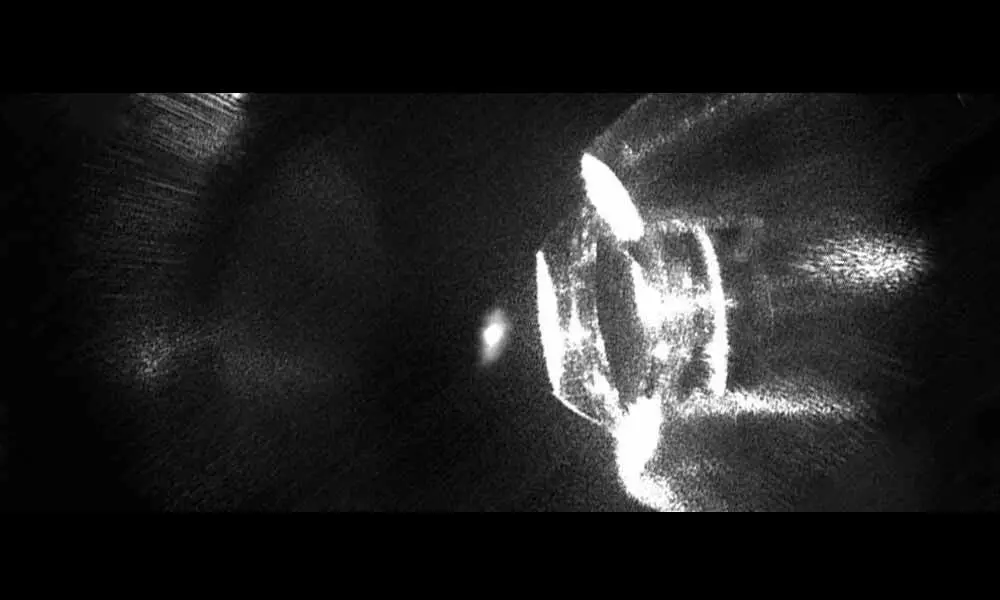Live
- Most Viewed and Liked Tollywood Movie Trailers in 24 Hours
- Channapatna Toy-Making Workshop Launched in Udupi
- Investors shift towards multi-asset strategy in volatile week for Indian stock markets
- DPIIT joins Stride Ventures to help Indian startups go global
- Decorative lighting a big charm of Kumbh
- Samsung Galaxy S23 Ultra Price Slashed Before Galaxy S25 Ultra Launch
- CCTV clip indicates cop not at fault
- Govt to integrate AYUSH with modern medicine: Nadda
- India’s office lease market zooms to record high, Bengaluru leads: Report
- Balanced diet key to better life: Dr Mithra
Just In
In a Huge First, Physicists Have Captured Individual Atoms And Watched Them Merge


To understand how atoms unite to turn into molecules, we need to catch them in action.
To understand how atoms unite to turn into molecules, we need to catch them in action. But to do that, physicists must force atoms to pause long enough for their exchanges to be recorded. That's no easy task, and one physicist from the University of Otago has only just recently achieved.
Until now, the best physicists could do to understand the finer points of various atomic interactions was to calculate correlations based on averages among a crowd that's been chilled down to the point that they all share an identity.
This crowd-sourced version of atomics provides plenty of useful insights, but can't capture key details on the bump and grind of collisions between separate particles that sends some scattering and others merging.
Even if you do happen to capture a handful of atoms in one space, every collision risks sending atoms careening out of your experiment.
One way to analyse such encounters is to grab isolated atoms with the equivalent of a tiny pair of tweezers, hold them still, and record the changes as they meet.
Fortunately, just such a pair of tweezers exists. Made from specially aligned polarised light, these laser-based forceps can act as optical traps for tiny objects.
Given short enough light waves, an experimenter has a good chance of trapping something as tiny as an individual atom in its pinch. Of course, first, the atoms need to be cooled right down to make them easier to catch, and then separated into an empty space.
Describing it this way makes it sound easy. But it's a process that requires the right technology and a lot of patience to achieve.
"Our method involves the individual trapping and cooling of three atoms to a temperature of about a millionth of a Kelvin using highly focused laser beams in a hyper-evacuated (vacuum) chamber, around the size of a toaster," says physicist Mikkel F. Andersen.
"We slowly combine the traps containing the atoms to produce controlled interactions that we measure."
The atoms, in this case, were all of the rubidium variety, which bond to form molecules of dirubidium, but just two atoms are not enough to achieve this.
"Two atoms alone can't form a molecule, it takes at least three to do chemistry," says physicist Marvin Weyland.
Modelling how this takes place is a real challenge. It's clear that two atoms have to come close enough in such a way that they can form a bond, while a third takes away a portion of that bonding energy to leave them connected.
Working out the mathematics of how just two atoms meet to build a molecule is hard enough. Taking into account the actions of any more can be a nightmare.
Three-body recombination between atoms should, in theory, cause them to be forced out of their trap, usually adding yet one more problem for physicists trying to study interactions between multiple atoms.
Using a special camera to magnify the changes, the team captured the moment the rubidium particles came close together, revealing the rate of loss wasn't anywhere near as common as expected.
In effect, it also means the molecules weren't coming together as quickly as existing models could explain.
Something about the confinement of the atoms and short-range quantum effects might help to explain this slowness, but the fact its unexpected means there's plenty of physics to be explored using this process.
"Our work is the first time this basic process has been studied in isolation, and it turns out that it gave several surprising results that were not expected from the previous measurement in large clouds of atoms," says Weyland.
"With development, this technique could provide a way to build and control single molecules of particular chemicals."
Further experiments will help to refine those models to better explain how groups of atoms operate together to meet and bond under various conditions.
In a world of ever-shrinking tech, it's not hard to imagine a need for processes where microscopic circuits and advanced medications are built atom-by-atom, one union at a time.
"Our research tries to pave the way for being able to build at the very smallest scale possible, namely the atomic scale, and I am thrilled to see how our discoveries will influence technological advancements in the future," says Andersen.
Source: sciencealert.com

© 2024 Hyderabad Media House Limited/The Hans India. All rights reserved. Powered by hocalwire.com






